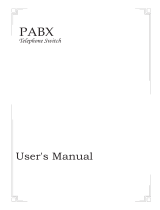PT Programming Manual 5
[303] Special Carrier Access Code..................................................................................................................33
[304] Emergency Number................................................................................................................................33
[320] ARS Mode ..............................................................................................................................................33
[321] ARS Leading Number.............................................................................................................................34
[322] ARS Routing Plan Table Number............................................................................................................34
[325] ARS Exception Number..........................................................................................................................34
[330] ARS Routing Plan Time Table ................................................................................................................34
[331–346] ARS Routing Plan Table (1–16) (KX-TDA30/KX-TDA100/KX-TDA200 only)..................................35
[347] ARS Routing Plan Table (1–48) (KX-TDA600 only)................................................................................35
[350] ARS Carrier Name..................................................................................................................................35
[351] ARS Trunk Group for Carrier Access......................................................................................................35
[352] ARS Removed Number of Digits for Carrier Access...............................................................................35
[353] ARS Carrier Access Code ......................................................................................................................36
2.1.7 Trunk Programming ......................................................................................................... 37
[400] LCOT/BRI Trunk Connection ..................................................................................................................37
[401] LCOT/BRI Trunk Name ...........................................................................................................................37
[402] LCOT/BRI Trunk Group Number.............................................................................................................37
[409] LCOT/BRI Trunk Number Reference ......................................................................................................37
[410] LCOT Dialling Mode................................................................................................................................37
[411] LCOT Pulse Rate....................................................................................................................................37
[412] LCOT DTMF Minimum Duration .............................................................................................................38
[413] LCOT CPC Signal Detection Time—Outgoing .......................................................................................38
[414] LCOT CPC Signal Detection Time—Incoming .......................................................................................38
[415] LCOT Reverse Circuit .............................................................................................................................38
[416] LCOT Pause Time ..................................................................................................................................38
[417] LCOT Flash/Recall Time.........................................................................................................................38
[418] LCOT Disconnect Time...........................................................................................................................38
[420] BRI Network Type ...................................................................................................................................39
[421] BRI DIL/DDI/MSN Selection ...................................................................................................................39
[422] BRI Subscriber Number..........................................................................................................................39
[424] BRI Layer 1 Active Mode ........................................................................................................................39
[425] BRI Layer 2 Active Mode ........................................................................................................................39
[426] BRI Configuration ...................................................................................................................................39
[427] BRI TEI Mode .........................................................................................................................................40
[450] DIL 1:1 Destination .................................................................................................................................40
[451] DID Number............................................................................................................................................40
[452] DID Name ...............................................................................................................................................40
[453] DID Destination.......................................................................................................................................40
[470] Trunk Group Intercept Destination (not applicable for MPR Software File Version 3.1000 or later) .......41
[471] Host PBX Access Code ..........................................................................................................................41
[472] Extension-to-Trunk Call Duration ............................................................................................................41
[473] Trunk-to-Trunk Call Duration ...................................................................................................................41
[475] DISA Silence Detection ..........................................................................................................................41
[476] DISA Continuous Signal Detection .........................................................................................................42
[477] DISA Cyclic Signal Detection..................................................................................................................42
[490] Caller ID Signal Type ..............................................................................................................................42
[491] Pay Tone Signal Type (KX-TDA100/KX-TDA200/KX-TDA600 only) .......................................................42
2.1.8 COS Programming .......................................................................................................... 43
[500] Trunk Group Number ..............................................................................................................................43
[501] TRS/Barring Level...................................................................................................................................43
[502] Trunk Call Duration Limitation .................................................................................................................43
[503] Call Transfer to Trunk ..............................................................................................................................43
[504] Call Forwarding to Trunk .........................................................................................................................43
[505] Executive Busy Override.........................................................................................................................44
[506] Executive Busy Override Deny ...............................................................................................................44
[507] DND Override .........................................................................................................................................44
[508] Account Code Mode ...............................................................................................................................44
[509] TRS/Barring Level for System Speed Dialling ........................................................................................44
[510] TRS/Barring Level for Extension Dial Lock .............................................................................................44






















